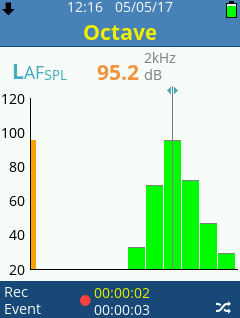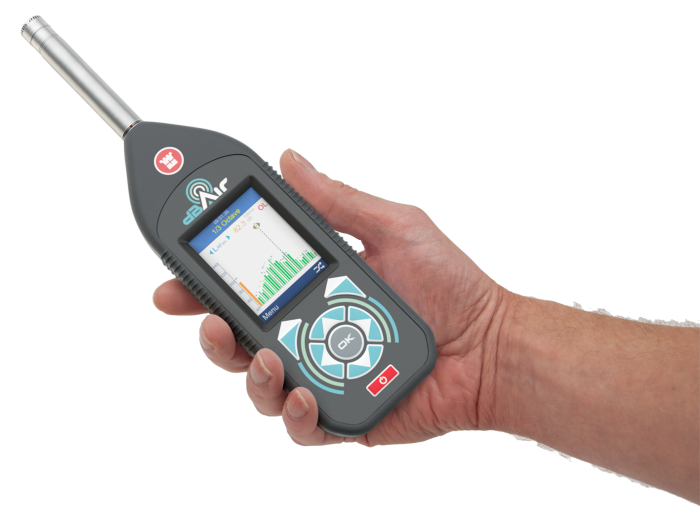What are Octave Bands and why are they used?
Octave Bands – What are they and why are they used?
Octave Bands offer a filtering method of splitting the audible spectrum into smaller segments called octaves, allowing you to identify different noise levels across individual frequencies.
“A”, “C” and “Z” Weighted Noise Measurements
“A”, “C” and “Z” frequency weighted noise measurements offer conventional ways to measure sound, and we use each of these frequency weightings for different types of measurements. In short, your sound meter responds different to it’s input signal (the noise) in order to provide us with data in relation to the application measuring for. E.g, “A” weighted noise measurements are used whenever humans are involved, as the sound meter will respond in a similar way to a human ear.
Using these frequency weightings alone provide a good basis to analyse your data, but to analyse different sound sources can be difficult without Octave Bands.
1/1 Octave Band Noise Measurements
1/1 Octave Band measurements are used when the frequency composition of a sound field is needed to be determined. Octave analysis is often used in noise control, hearing protection and sometimes in environmental noise issues.
The common octave frequency bands are: — 31Hz, 63Hz, 125Hz, 250Hz, 500Hz, 1kHz, 2kHz, 4kHz, 8kHz and 16kHz – and their composition is made up of the Lower Band Limit, Centre Frequency and Upper Band Limit.
The graph in Fig. 1 below shows an example of a typical octave band spectrum, where the level at 250Hz is greatest.

Figure 1 – Single Octave Bands
Although octave frequency bands (Base 10) are defined and named by their “Centre Frequency”, the characteristics are quite broad and internationally standardised. The simple method to calculate the span of each band is a multiplication of the Centre Frequency:
Calculating the Lower Band Limit: Centre Frequency x 0.707
Calculating the Upper Band Limit: Centre Frequency x 1.412
For example:
2 kHz band is made up of:
Lower Band Limit: 1.41 kHz Centre Frequency: 2 kHz Upper Band Limit: 2.82 kHz
Fig. 2 displays a screengrab from the dBAir Sound Level Meter in 1/1 Octave view and in this case you can see the 2 kHz is showing the highest level.
Having this determination can be valuable when you’re trying to reduce noise levels.

Figure 2 – 1/1 Octave Screen

Figure 3 – 1/3 Octave Screen
1/3 Octave Band Noise Measurements
Mainly used in environmental and noise control applications, 1/3 Octave Bands provide a further in-depth outlook on noise levels across the frequency composition.
Each 1/1 (single) Octave is further split into three, providing a more detailed view of noise content.
Fig. 3 displays a screengrab from the dBAir Sound Level Meter in 1/3 Octave view taking the same readings as in Fig. 2. As you can see, each 1/1 Octave is broken down into three.
Octave Bands in Sound Meters and Noise Monitoring
Although Octave Bands are only required for a selection of noise monitoring applications, many of the compliant Sound Level Meters on the market today will offer an option of Octave Band analysis.
Some examples of applications where understanding the frequency content of your measurements is necessary are:
- Noise Reduction and Control
- Building Acoustics
- Machinery and Product Testing
- Octave Band Hearing Protection Assessments – Many Sound Meters today include software which calculates your hearing protection assessments for you, and the Castle dBAir includes a vast database of hearing protection to help you select suitable equipment – straight from the meter.
-

Castle Products
CLICK HERE FOR
Information, technical data, images and pricing of all Castle Group Ltd. products -

Product Rental
CLICK HERE FOR
Hire the best equipment at a fraction of the purchase price -

Calibration Lab.
CLICK HERE FOR
Calibration and repair services from Air Samplers to Vibration Meters -

Training
CLICK HERE FOR
World class safety and environmental courses. On your site or our 4* training facility -

Consultancy
CLICK HERE FOR
Employ our expertise for both simple and more demanding issues.













